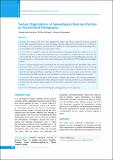Please use this identifier to cite or link to this item:
https://hdl.handle.net/20.500.14356/1036| Title: | Textual Organization of Hemodialysis Nursing Practice: An Institutional Ethnography |
| Authors: | Acharya, Devaka Kumari Nilmanat, Kittikorn Boonyasopun, Umaporn |
| Citation: | AcharyaD. K., NilmanatK., & BoonyasopunU. (2022). Textual Organization of Hemodialysis Nursing Practice: An Institutional Ethnography. Journal of Nepal Health Research Council, 20(01), 180-185. https://doi.org/10.33314/jnhrc.v20i01.4023 |
| Issue Date: | 2022 |
| Publisher: | Nepal Health Research Council |
| Article Type: | Original Article |
| Keywords: | Hemodialysis institutional ethnography nursing practice textual organization |
| Series/Report no.: | Jan-March, 2022;4023 |
| Abstract: | Abstract Background: Nursing today deals with organizational changes and reforms within the increased demands of care amid competing resources. In some developing countries, dealing with text documents is a challenge in hemodialysis service organizations. This study aimed to explicate the social organization of textual nursing practices in a hemodialysis unit of a public university hospital in Nepal. Methods: This is a qualitative study that followed institutional ethnography design. Ten registered nurses who worked for at least six months in the hemodialysis unit were included for in-depth interviews. Data were also collected through 167 hours of observations, field notes, and two focus groups. Texts including policy, protocols, and record documents were incorporated in the analysis. Data analysis followed Smith's (1987) institutional ethnographic analysis. Results: Nepalese nursing work in a hemodialysis unit was mainly organized by the free hemodialysis policy of the government which was not available to the nurses at the hemodialysis unit, but it determined most of the nursing activities of patient care and documentation. Hemodialysis record form, hemodialysis schedule, and free hemodialysis claim form also had a great influence on nursing work. However, the nurses were not quite aware of how the textual documents determined their practices to meet the politico-economic interests of the hospital and government. Conclusions: The hospital and Nepal’s health ministry established the activities and recording requirements. Identification of texts and exploration of their influences on nurses’ decisions, patient care, and documentation are essential to find the optimal solutions in daily care and determine the appropriate support for nurses in hemodialysis settings. Keywords: Hemodialysis; institutional ethnography; nursing practice; textual organization. |
| Description: | Original Article |
| URI: | http://103.69.126.140:8080/handle/20.500.14356/1036 |
| ISSN: | Print ISSN: 1727-5482; Online ISSN: 1999-6217 |
| Appears in Collections: | Vol. 20 No. 01 (2022): Issue 54 Jan-March, 2022 |
Files in This Item:
| File | Description | Size | Format | |
|---|---|---|---|---|
| 4023-Manuscript-27890-1-10-20220606.pdf | Fulltext Download | 464.4 kB | Adobe PDF |  View/Open |
Items in DSpace are protected by copyright, with all rights reserved, unless otherwise indicated.
